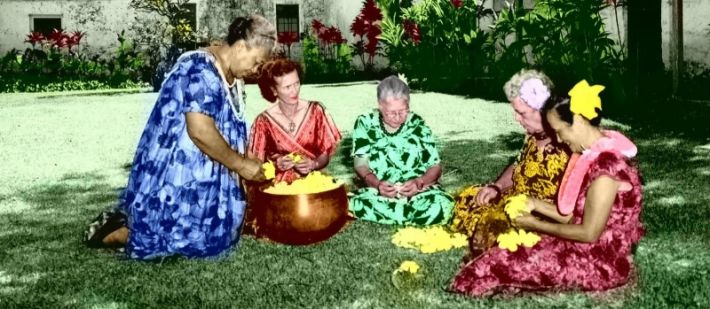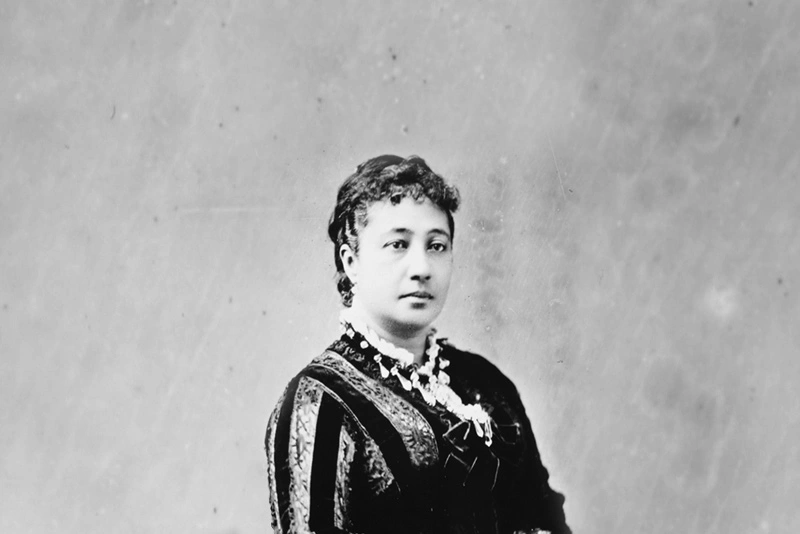This Kūkahekahe Cultural Conversations column celebrating May Day and Lei Day is contributed by Hoʻokahua Cultural Specialist Nanea Armstrong-Wassel. It is a reprise of an article originally shared in 2017 but the timeless nature of these celebrations merits another read!
Modern May Day celebrations in Hawaiʻi bring together traditional Hawaiian symbolism and contemporary pageantry. The symbols employed in these celebrations – colors, beloved aliʻi, mountains, flora and fauna, and so on – have long-standing associations with particular islands.
These associations continue today, as the symbolic color and floral emblem of each island are often noted in mele and moʻolelo. The first the mele to record all the island symbols was composed shortly after the turn of the 19th century.
Nā Lei o Hawaiʻi
Reverend Samuel Kapū of Maui wrote “Nā Lei O Hawaiʻi” (The Wreaths of Hawaiʻi). This mele was dedicated to the goddess Hiʻiakaikapoliopele, whose epic journey took her across Nā Kai ʻEwalu (the eight seas/channels of Hawaiʻi). The mele mentions the flower symbol of each island. Kapū’s mele of the many lei of Hawaiʻi was set to music by Peleuli Amalu and sung in 1901 in Hoʻokena, South Kona, on Hawaiʻi Island at a concert for Pukaʻana Church.
When the Amalus returned to Oʻahu in 1903, they continued to perform the mele at church and it quickly became a hōʻike favorite. Six years later, in 1909, the Kaʻahumanu Society members sang the song at the old Opera House, formerly located next to Aliʻiōlani Hale, the judiciary building.
The society had young women acting out the song by representing each island while adorned with the appropriate color and lei. The pageant-like event garnered many admirers who soon followed suit by adding in pāʻū-riding royal courts using this song as the template for color and flower assignments.
By 1912, the colors had become customary and the popularized performance of Reverend Kapū’s “Nā Lei O Hawaiʻi” mele by the Kaʻahumanu Society inspired Charles E. King’s version of “Nā Lei O Hawaiʻi” in 1914.
Both versions describe each island with an identifying flower, color, chief, or with a famed seascape or landscape.
Why do we celebrate May Day as Lei Day on May 1st in Hawaiʻi?
In 1923, the Hawaiʻi Territorial Legislature passed Joint Resolution No. 1 acknowledging floral emblems. The Outdoor Circle initiated this resolution, which sought to name the hibiscus (aloalo) as the flower emblem of the territory. Their successful reasoning relied on the widely-accepted knowledge of the connection between designated colors, lei, and respective islands.
May Day celebrations as we know them with the royal courts dressed in their island colors, wearing their island lei, find their origin in the first lei contest held on May 1, 1928 – referred to as Lei Day.
Don Blanding, originally from Oklahoma, came to Hawaiʻi in 1915 after seeing a play in Kansas City called “The Bird of Paradise” that depicted a romantic (and completely fictional) Hawaiʻi. His first local success came in writing newspaper ads for Ajinomoto Foods. From there, he grew into being a successful writer, distinctive artist, and the author of many books.
In 1927, Blanding and a fellow “Honolulu Star-Bulletin” newspaper writer named Grace Tower Warren came up with the idea of honoring the tradition of the lei, which they thought to be in decline. The first Lei Day was held on May 1, 1928 and was a resounding success.
It took place in the lobby of Bank of Hawaiʻi and the official judges that day were: Princess Abigail Wahiikaahuula Campbell, Elizabeth Lahilahi Webb (lady-in-waiting for Queen Liliʻuokalani) and Aliʻi Lucy Kalanikiʻekiʻe Davis. The festival included a lei competition in which lei were judged based on the appropriate use of flowers and colors of islands as designated in 1923 by Hawaiʻi’s Territorial Legislature’s Joint Resolution 1.
Ever since this inaugural lei competition in 1928, we continue to celebrate May Day in Hawaiʻi as being synonymous with Lei Day. It is our unique and special way to celebrate our shared traditions, as memorialized in song:
May Day is Lei Day in Hawaiʻi
Garlands of flowers everywhere
May Day is Lei Day in Hawaiʻi
May Day is happy day out here

Wāhine stringing lei. No date. Courtesy of the Hawaiʻi State Archives.

A May Day court celebration. No date. Courtesy of the Hawaiʻi State Archives.
TAGS
hookahua,hawaiian culture,kūkahekahe,cultural conversations,may day
CATEGORIES
Kaipuolono Article, Regions, Themes, Culture, Community, Newsroom, Community Education, Department News
Print with photos
Print text only










